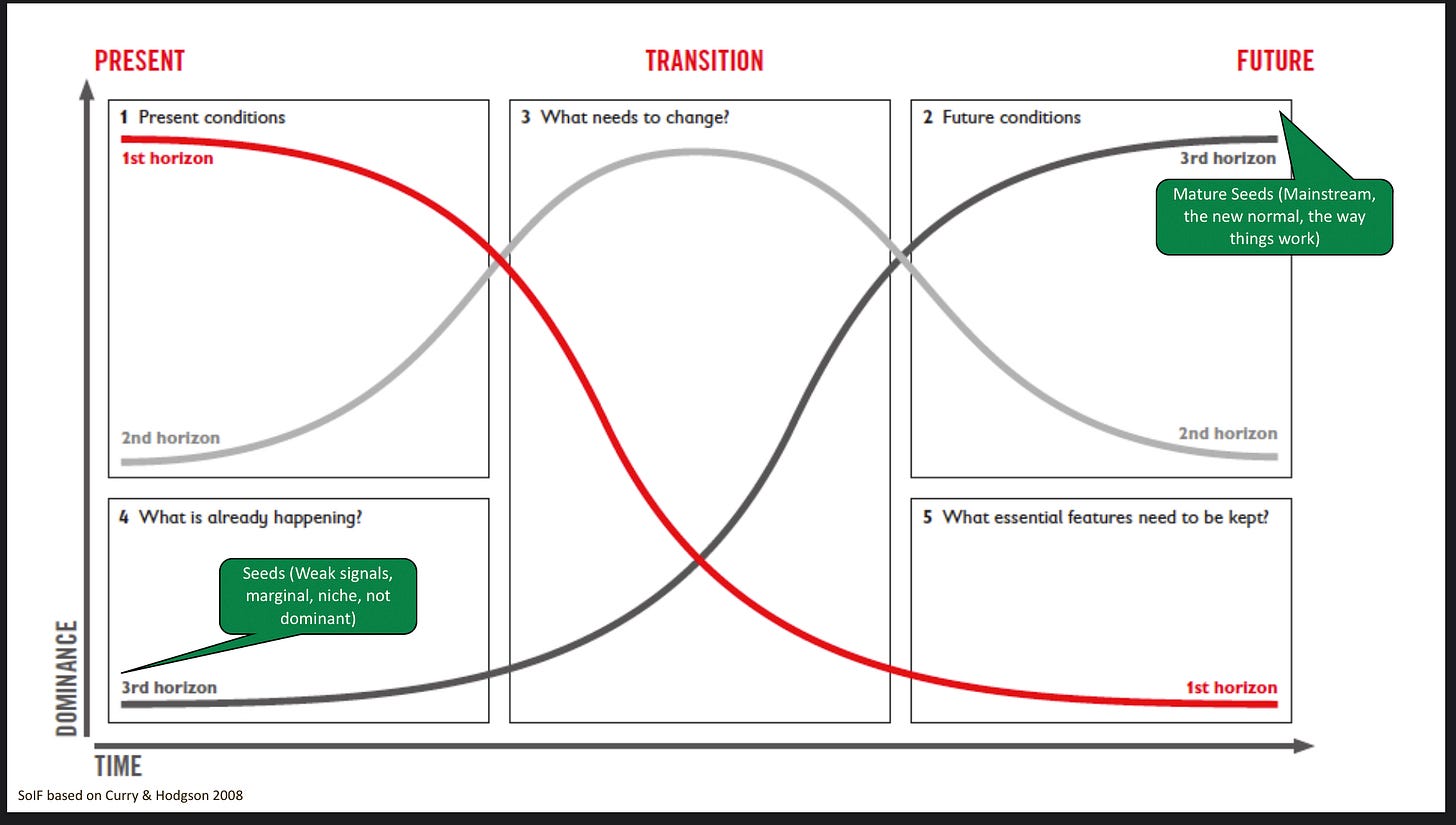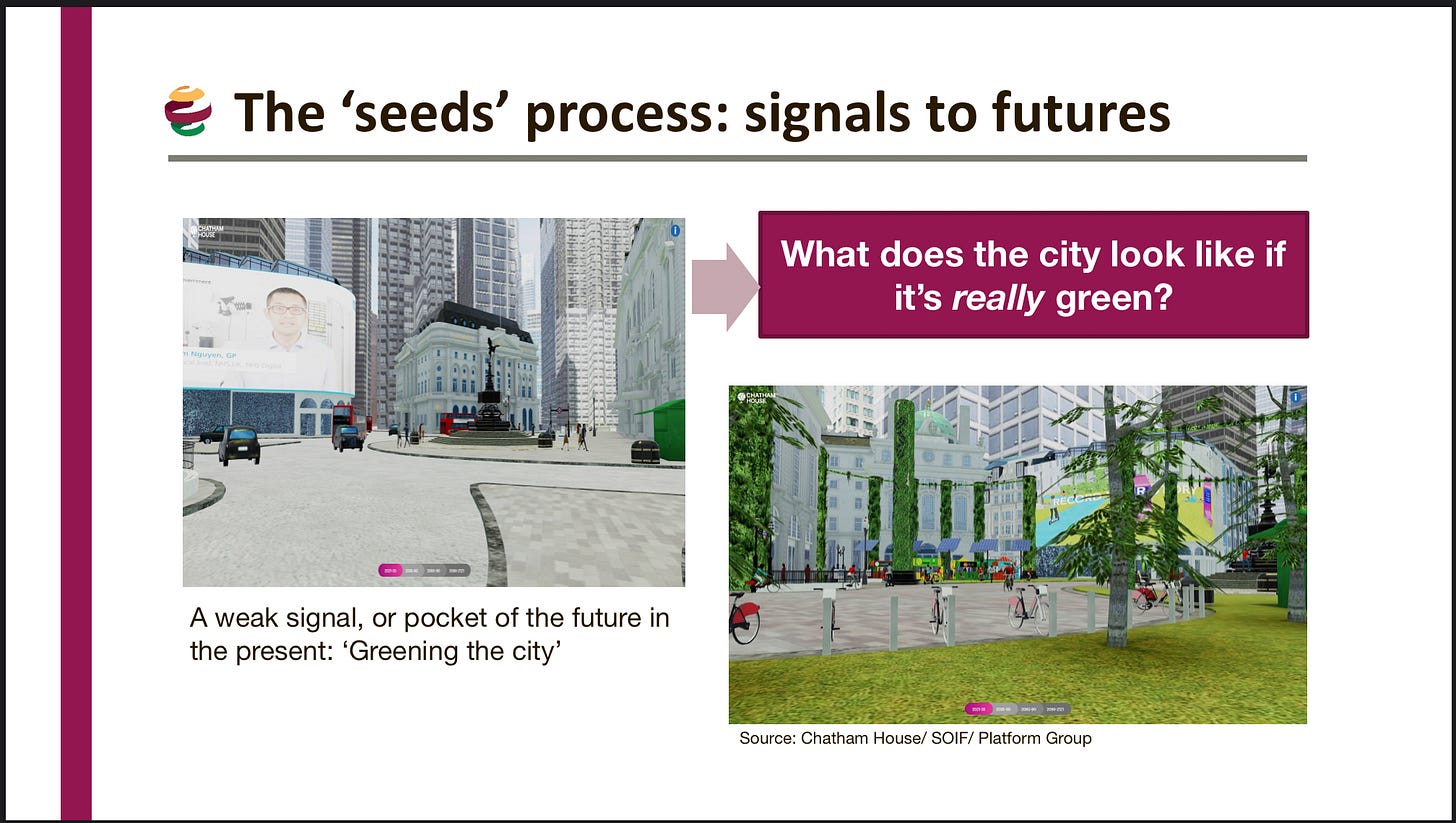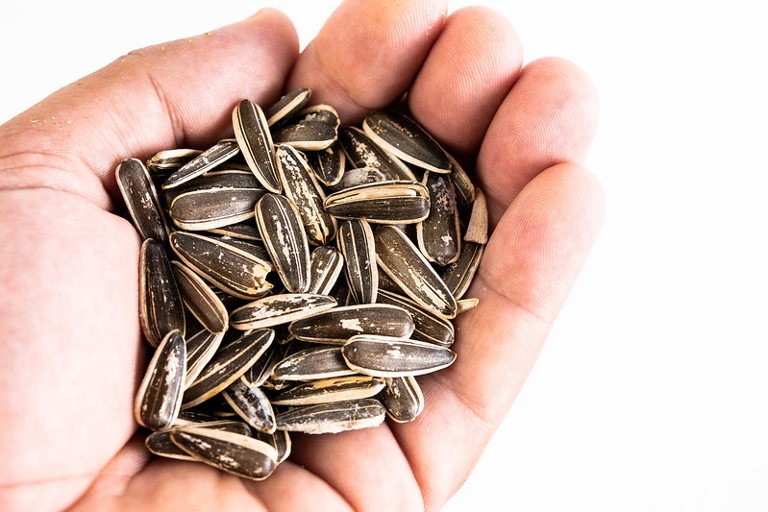One of the tough parts of futures work is helping people step out of the present. The sheer weight of how we do things and think about things right here, right now, gets in the way of people imagining how things can change for the better.
One method that I’ve used—and I’m very much standing on the shoulders of the futurists Wendy Schultz and Tanja Hichert here—is the idea of ‘Seeds of Change’. The phrase was developed by the Good Anthropocene Project, which developed a Seed Bank as part of its work. Tanja and I presented on this at an Association of Professional Futurists’ conference a while ago.
Maximising difference
The Good Anthropocene project in turn built on Wendy Schultz’ Manoa Scenarios method, which used weak signals or ‘pockets of the future in the present’ as its initial building block. The Manoa scenarios model, which is designed—Wendy’s words—to “maximise difference”, starts by placing a set of weak signals at the heart of a set of futures wheels, and the scenarios emerge from this process.
And a seed is defined like this (by the Good Anthropocene Project) as a small sign of a positive future:
‘Seeds are likely not widespread nor well-known. They can be social initiatives, new technologies, economic tools, or social-ecological projects, or organisations, movements or new ways of acting that appear to be contributing to the creation of a future that is just, prosperous, and sustainable.’
Increasing resilience
The Seeds of the Good Anthropocene project was designed to help communities in Southern Africa identify ways of increasing their resilience in the face of climate change. It combines a number of methods, including Wendy’s Manoa method and three horizons, but its other innovation was to start the process not with a weak signal, emerging at the margins, but with the ‘mature’ version of that seed. What happens, in other words, if that seed has grown in such a way that if has become mainstream. It needs to be grown into a tree, in other words.
In other words, at least for readers who’re familiar with Three Horizons, it has moved from the bottom left of the Horizon 3 ‘visionary’ S-curve to the top.

Or to put it another way: planners have started to add trees to urban landscapes, but not with any intent (these images are from a project about re-imagining Piccadilly Circus for Chatham House, animated by the Platform Group). What if we decide we’re serious about trees?

(Image: Chatham House/Platform Group)
Change for the better
I used this approach in the Community Futures/Better Futures Wales method that SOIF piloted last year with Wales Community and Voluntary Action. We started with developing mature seeds, and it opened space in the (virtual) room for people to imagine worlds in which change for the better was possible.
Typically you need to combine this with other techniques—both the Good Anthropocene (borrowing from Manoa) and the Better Futures Wales project use Futures Wheels, if in slightly different ways. And although visioning is, I think, an essential component in helping to build agency, you also need to help people start somewhere rather than be left hanging in an imagined future. It’s not coincidence that both projects used Three Horizons as a way to build a narrative about what to do in the ‘entrepreneurial’ Horizon 2.
The question matters
But it’s also a reminder that the way you ask people about the future matters. Robert Jungk tells a story in his book Future Workshops (sadly out of print) about a group of teenagers whose views on the future had seemed unremittingly gloomy when they were asked about them in school.
When he started his work with them, he found to his surprise that they were quite animated about possible futures. He asked them what had changed. Their answer: the school asked us about the future we expected, but you asked us about the future we wanted.
Growing the seeds
Anyway, the handbook for the Better Futures Wales project sets out these steps for building ‘mature seeds’, as well as connecting them to a whole community futures process:
Check your potential Seeds of Change against these simple statements:
• A seed is anything that is innovative, already happens and points to a positive future, but is not well-known or widespread.
• A good seed would have people excited and inspire them to think of how their own community could change.
• It should be novel and not exist at scale in your community but should actually be possible.
• It should stretch the imagination and help the community dream beyond your existing conversations.
• It should energise or even excite the group when they discuss it, and they should feel comfortable using it at the start of the process.
If your potential Seed of Change meets most of these criteria, re-write its description in the present tense, as if it already exists and has grown beyond a mere idea to being mainstream or commonplace. For instance, the seed of a single repair cafe has grown into a place where everything can be repaired, or the seed of a single community bus has become a free transport network! Writing the description about your Seed of Change in such a way makes it easier for participants to understand its impact.
———————
A version of this article was also published on my Just Two Things Newsletter.
Photo by Marco Verch/flickr. CC BY 2.0.





